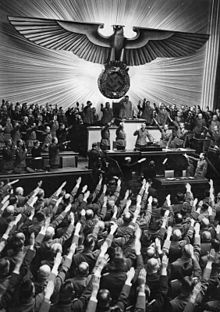
Back Diktatorskap Afrikaans Diktatur ALS Dictadura AN तानाशाही ANP ديكتاتورية Arabic ܫܘܠܛܢ ܛܪܘܢܘܬܐ ARC ديكتاتورية ARY نظام دكتاتوري ARZ Dictadura AST Диктатура AV

| Part of the Politics series |
| Basic forms of government |
|---|
| List of countries by system of government |
|
|
A dictatorship is an autocratic form of government which is characterized by a leader, or a group of leaders, who hold governmental powers with few to no limitations. Politics in a dictatorship are controlled by a dictator, and they are facilitated through an inner circle of elites that includes advisers, generals, and other high-ranking officials. The dictator maintains control by influencing and appeasing the inner circle and repressing any opposition, which may include rival political parties, armed resistance, or disloyal members of the dictator's inner circle. Dictatorships can be formed by a military coup that overthrows the previous government through force or they can be formed by a self-coup in which elected leaders make their rule permanent. Dictatorships are authoritarian or totalitarian,[1] and they can be classified as military dictatorships, one-party dictatorships, personalist dictatorships, or absolute monarchies.[2]
The Latin word dictator originated in the early Roman Republic to refer to a constitutional office with "a temporary grant of absolute power to a leader to handle some emergency."[3] The earliest military dictatorships developed in the post-classical era, particularly in Shogun-era Japan and in England under Cromwell. Modern dictatorships first developed in the 19th century, which included Bonapartism in Europe and caudillos in Latin America. The 20th century saw the rise of fascist and communist dictatorships in Europe; fascism was eradicated in the aftermath of World War II in 1945, while communism spread to other continents, maintaining prominence until the end of the Cold War in 1991. The 20th century also saw the rise of personalist dictatorships in Africa and military dictatorships in Latin America, both of which became prominent in the 1960s and 1970s.
The period following the collapse of the Soviet Union witnessed a sporadic rise in democracies across the world, despite several dictatorships persisting into the 21st century, particularly in Africa and Asia. During the early 21st century, democratic governments came to outnumber authoritarian states by 98 to 80. The second decade was marked by a democratic recession, following the 2008 global financial crisis which drastically reduced the appeal of the Western model across the world. By 2019, the number of authoritarian governments had again surmounted that of democracies by 92 to 87.[3]
Dictatorships often attempt to portray a democratic facade, frequently holding elections in order to establish their legitimacy or provide incentives to members of the ruling party, but these elections are not competitive for the opposition. Stability in a dictatorship is maintained through coercion and political repression, which involves the restriction of access to information, the tracking of the political opposition, and acts of violence. Dictatorships that fail to repress the opposition are susceptible to collapse through a coup or a revolution.
- ^ "What is the difference between totalitarianism and authoritarianism?". Encyclopedia Britannica. 12 March 1965. Retrieved 13 January 2024.
- ^ Wintrobe, Ronald (28 February 2019). "Are There Types of Dictatorship?". In Congleton, Roger D.; Grofman, Bernard; Voigt, Stefan (eds.). The Oxford Handbook of Public Choice, Volume 2. Oxford University Press. pp. 285–310. doi:10.1093/oxfordhb/9780190469771.013.13. ISBN 978-0-19-046977-1.
- ^ a b Guriev, Treisman, Sergeiand, Daniel (6 December 2022). "How Do Dictatorships Survive in the 21st Century?". Carnegie Corporation of New York. Archived from the original on 16 April 2023.
{{cite web}}: CS1 maint: multiple names: authors list (link)
© MMXXIII Rich X Search. We shall prevail. All rights reserved. Rich X Search